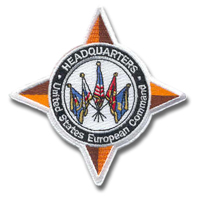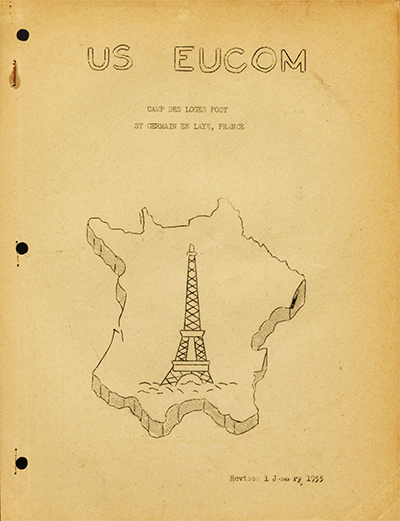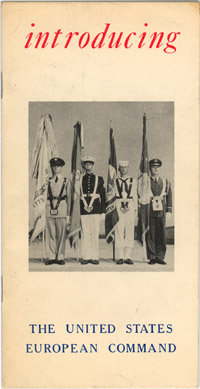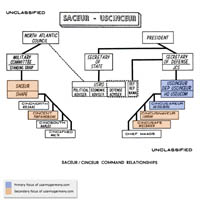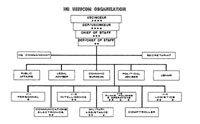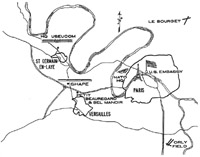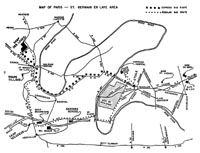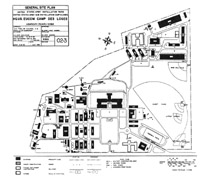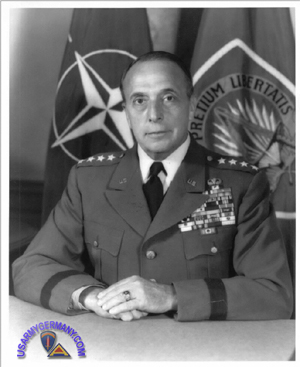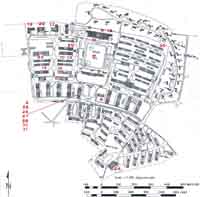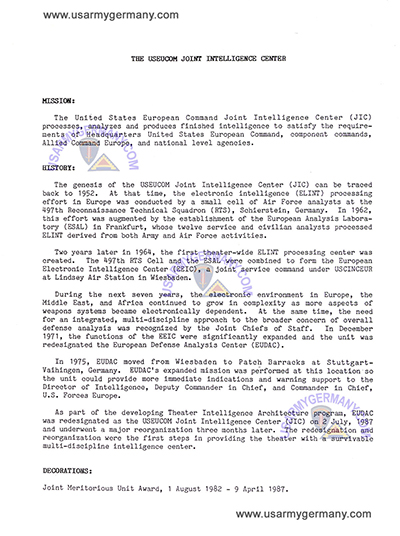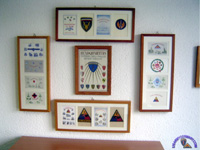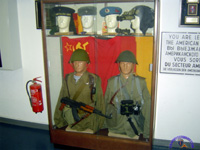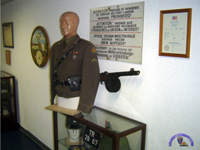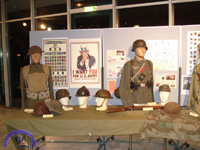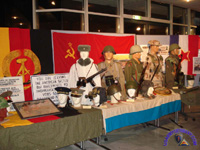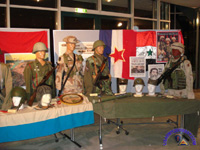| If you do
NOT see the Table of Contents frame to the left of this page, then
Click here to open 'USArmyGermany' frameset |
|||||||||||||||||||||||||||||||||||||||||||||||||||||||||||||||
|
US European Command |
|||||||||||||||||||||||||||||||||||||||||||||||||||||||||||||||
|
|
|||||||||||||||||||||||||||||||||||||||||||||||||||||||||||||||
|
|||||||||||||||||||||||||||||||||||||||||||||||||||||||||||||||
|
|
|||||||||||||||||||||||||||||||||||||||||||||||||||||||||||||||
| History | |||||||||||||||||||||||||||||||||||||||||||||||||||||||||||||||
|
|||||||||||||||||||||||||||||||||||||||||||||||||||||||||||||||
 USEUCOM DUI USEUCOM DUI |
|||||||||||||||||||||||||||||||||||||||||||||||||||||||||||||||
| 1952 - present | |||||||||||||||||||||||||||||||||||||||||||||||||||||||||||||||
| (Source: U.S. European Command Press Kit, official USEUCOM web site) | |||||||||||||||||||||||||||||||||||||||||||||||||||||||||||||||
Although the Headquarters United States European Command was formally established at "00001 Zebra [sic] hours, 1 August 1952," its activation can be seen as an evolutionary process, which actually began in the European Theater of Operations (ETO) during the Second World War. This process has subsequently been shaped by the onset, escalation and end of the Cold War. At the close of World War II, U.S. troops in Europe were under dual command. Operational control was exercised by the combined (US/UK) "Supreme Headquarters, Allied Expeditionary Forces (SHAEF)." The administration and supply of U.S. troops, were the responsibilities of the "European Theater of Operations, U.S. Army--Communications Zone (ETOUSA-COMZ)." Both SHAPE and ETOUSA-COMZ were commanded by General Dwight D. Eisenhower, who began to shift authority from the former to the latter as the war in Europe came to a close. Two weeks after the redesignation of ETOUSA-COMZ as "U.S. Forces, European Theater (USFET)" on 1 July 1945, SHAEFwas deactivated (14 July 1945). On 1 March 1946, the USFET "component commands" were identified as the: Seventh U.S. Army; U.S. Army Air Forces (former U.S. Strategic Air Force Europe); and U.S. Naval Forces, Germany. The National Security Act (NSA) of 1947 was designed ". . .to provide for the effective strategic direction of the armed forces and for their operation under unified control and for their integration into an efficient team of land, air and naval forces." In addition to the National Military Executive (which became the Department of Defense in 1949), the NSA established the U.S. Air Force, and (of particular significance for the history of USEUCOM) the unified and specified commands. The first attempt at creating a joint command in Europe was made on 15 March 1947 when the European Command (EUCOM) replaced USFET. The purpose of the reorganization was ". . .to place in the hands of a single commander responsibility for the conduct of military operations of the land, naval and air forces." Although EUCOM was planned as a joint command, it never truly became one. The EUCOM "component commands" as of 15 November 1947 were the: U.S. Army Europe (USAREUR); the U.S. Air Forces, Europe (USAFE); and the U.S. Naval Forces in Europe. The apparent "jointness" of the wiring diagram was, however, misleading as EUCOM and USAREUR had identical staff sections. The currency reform in the Western Zones of occupied Germany and the Western Sectors of Berlin, which took place on 20 June 1948, alarmed the Soviets and catalyzed the blockade of "Westberlin." The Berlin Blockade in turn inspired "Operation VITTLES," more commonly known as the Berlin Airlift (26 June 1948 -30 September 1949). The airlift clearly demonstrated the value of the unified execution of operations. General Lucius D. Clay, the Military Governor (U.S.) and Commander-in-Chief, European Command observed in April 1949 that: "Among our Armed Forces, the Airlift has become a symbol of unity, with the Air Force, Army and Navy all cooperating to the limit to fulfill the highest expression of American will--Freedom." The Soviet blockade of the three western sectors of Berlin also catalyzed the signing of the treaty, which established the North Atlantic Treaty Organization (NATO) on 4 April 1949 (effective date 24 August 1949). Following the invasion of South Korea by North Korean troops on 25 June 1950, NATO was vitalized. On 19 December 1950, General Eisenhower became the first Supreme Allied Commander Europe (SACEUR). He subsequently activated the Allied Command Europe (ACE) and established his headquarters at Roquencourt (Paris) on 2 April 1951. General Eisenhower was given the following authority by President Harry S. Truman: "You are hereby assigned operational command, to the extent necessary for the accomplishment of your mission, of the U.S. Army Forces, Europe; U.S. Air Forces, Europe; and the U.S. Naval Forces, Eastern Atlantic and Mediterranean." Given General Eisenhower's wartime experience in the ETO, it is not surprising that EUCOM was quickly drawn into a close working relationship with SHAPE/ACE, providing necessary resources and personnel. General Eisenhower was, however, reluctant to be "dual-hatted" as the commander of all U.S. Forces in Europe. On 19 May 1952 he informed the Joint Chiefs of Staff (JCS) that SACEUR would assume direct command of the U.S. Forces in Europe and established a separate staff under a deputy for the conduct of joint U.S. military affairs. General Eisenhower observed that: "A matter of great importance will be the rank, previous experience and ability of the officer who will be selected as my Deputy. Since, under my concept, this officer will have a maximum of delegated authority . . ., consulting me only on matters of fundamental policy and critical problems, it is essential that he be of four-star rank. . ." On 23 May 1952 the Joint Staff approved General Eisenhower's concept. Five days later, he appointed General Thomas T. Handy, USA, as his deputy and directed him to establish the "new" unified command. Following General Eisenhower's return to the United States, General Matthew B. Ridgway became SACEUR on 30 May, and subsequently declared his willingness to be dual-hatted as the United States Commander-in-Chief, Europe (USCINCEUR). In a letter of instruction dated 19 July 1952, General Ridgway made a delegation of authority to General Handy, which reflected the concept developed by General Eisenhower: ". . .you are hereby authorized to exercise for me, as my deputy, authority and direction in U.S. military matters of a joint nature within my cognizance as U.S. CINCEUR over all U.S. military commands and agencies subject to my command authority as U.S. CINCEUR. You are authorized to issue appropriate instructions in your own name and to take action in my behalf with higher authority and with appropriate agencies outside of this chain of command. I leave to your discretion the referral to me of those questions, including matters of fundamental policy and critical problems, which are of such nature or significance as to require my personal attention. You will keep me informed of your major actions, plans and decisions." This broad delegation of authority continues to serve as the model for the unique relationship between the CINCEUR and the "DCINC." On 1 August 1952, the three European commands--U.S. Naval Forces, Eastern Atlantic and Mediterranean; U.S. Air Forces in Europe; European Command (redesignated as USAREUR)--were combined under a "new" joint headquarters, the United States European Command (USEUCOM) From 1952 until 1986, the USEUCOM component commands retained a great deal of operational independence. The U.S. European Command was generally regarded as a logistics, planning and administrative headquarters. Following the passage of the Goldwater-Nichols Department of Defense Reorganization Act of 1986, which placed the authority of combat command (COCOM) firmly in the hands of the unified and specified combatant commanders, the focal point of the "one single concentrated effort" (General Eisenhower) began to shift to USEUCOM. This process was further accelerated by the organizational changes (e.g. drawdown) and the unique operational requirements, which followed in the wake of the political developments in Europe and the war in Southwest Asia. The Headquarters, U.S. European Command was "temporarily opened" at the I.G. Farben Hochhaus (the former C.W. Abrams Building) in Frankfurt in 1952, where it remained for two years. From 1954 until the "fast relocation" of the U.S. Forces from France in 1966 at the request of President Charles De Gaulle, HQ EUCOM was located near SHAPE at Camp-de-Loges on the outskirts of Paris. Following the collocation of HQ Seventh U.S. Army with HQ USAREUR in Heidelberg, HQ USEUCOM was relocated to Patch Barracks in Stuttgart-Vaihingen on 15 March 1967. The USEUCOM AOR has also continued to evolve during the past forty-four years. In 1952 it included continental Europe, the United Kingdom, North Africa and Turkey. The AOR was subsequently expanded to include Southwest Asia as far east as Iran and as far south as Saudi Arabia. With the establishment of the U.S. Central Command (USCENTCOM) in 1983, which assumed responsibility for most of the Middle East region, the USEUCOM AOR became Europe (including the United Kingdom and Ireland), the Mediterranean Sea (including the islands), and the Mediterranean littoral (excluding Egypt, Sudan, Kenya, Ethiopia, Somalia and Djibouti). Beginning in 1989, a sea-change swept over Central and Eastern Europe, dissolving both the Warsaw Pact and ultimately the Soviet Union itself. As a result, a number of "new" countries (with additional responsibilities) have been added to the AOR, bringing the current total to 91. It is important to note that although USEUCOM was "born" in Europe, its mission to promote stability and democratic growth among African and Asian (i.e. Middle Eastern) nations, is of equal importance. On 1 January 1989, the primary missions of the Commander-in-Chief (CINCEUR), United States European Command (USEUCOM) were essentially the same as they had been on 1 August 1952: to support the Supreme Allied Commander, Europe (SACEUR) and execute U. S. policies within the prescribed AOR. The politico-historical changes mentioned above coupled with developments outside of the AOR--of which the war in Southwest Asia (SWA) was undoubtedly the most visible--permanently changed the mission environment. Consequently, the Chief of Staff USEUCOM directed the formation of a working group to develop a new mission statement. On 27 August 1991, this working group recommended the following mission statement for the U. S. European Command: "Support and advance U. S. interests and policies throughout the area of assigned responsibility; provide combat ready land, maritime, and air forces to Allied Command Europe [ACE] or U.S. unified commands; and conduct operations unilaterally or in concert with coalition partners." In the meantime, this mission statement has been modified to reflect continuing change in the post-Cold War operational environment: "USEUCOM is a unified combatant command whose mission is to maintain ready forces to conduct the full spectrum of military operations unilaterally or in concert with the coalition partners; to enhance transatlantic security through support NATO; to promote regional stability; and advance U.S. interests in Europe, Africa, and the Middle East." A brief review of some of the major operations since 1989, in which the U.S. European Command has been involved as either the "supported" or a "supporting" command, provides an overview of not only the scope and the importance of USEUCOM's more recent missions, but of its achievements as well. |
|||||||||||||||||||||||||||||||||||||||||||||||||||||||||||||||
Commanders and Deputy Commanders in Chief, |
|||||||||||||||||||||||||||||||||||||||||||||||||||||||||||||||
The first table lists the United States Commanders in Chief, Europe (USCINCEUR), starting with the current Commander, General Joseph W. Ralston. The Commander in Chief (ECCC) supports U.S. interests and policies in the EUCOM area of responsibility, provides combat ready forces, and conducts operations unilaterally or in concert with coalition partners. He also serves as Supreme Allied Commander Europe (SACEUR) - NATO's senior military commander in Europe. The passing of command is symbolized in a Change of Command ceremony, as the outgoing USCINCEUR passes the unit flag to the incoming USCINCEUR. This formal event ensures absolute continuity in command authority. As a result, the date command is assumed by the successor is also the same date the predecessor's command is completed. United States Commanders in Chief, Europe (USCINCEUR) |
|||||||||||||||||||||||||||||||||||||||||||||||||||||||||||||||
|
|||||||||||||||||||||||||||||||||||||||||||||||||||||||||||||||
The second table lists the United States Deputy Commanders in Chief, Europe (USDCINCEUR), starting with the current Deputy Commander, Carlton W., Fulford Jr. The Deputy Commander in Chief (ECDC) supports the Commander in Chief in the advance of U.S. interests and policies throughout the United States European Command's assigned area of responsibility. To ensure command continuity, the incoming USDCINCEUR also assumes the position at the same moment that the incumbent transfers authority. That means the start date of the current leader is the same as the end date of the previous leader. United States Deputy Commanders in Chief, Europe (DCINCEUR) |
|||||||||||||||||||||||||||||||||||||||||||||||||||||||||||||||
|
|||||||||||||||||||||||||||||||||||||||||||||||||||||||||||||||
| 1963 | |||||||||||||||||||||||||||||||||||||||||||||||||||||||||||||||
| (Source: Introducing the United States European Command, USEUCOM information brochure, around 1963) | |||||||||||||||||||||||||||||||||||||||||||||||||||||||||||||||
| INTRODUCTION USEUCOM . . . WHAT IS IT? The United States European Command -- USEUCOM -- is one of seven unified commands operating under the Joint Chiefs of Staff. It directs the activities of more than one-third of a million US military personnel in Europe, Africa, and the Middle East -- an area of five million square miles, nearly twice the size of the United States. USCINCEUR also is responsible for the administration of the Military Assistance program within its area of responsibility; plus certain MAAGs and Missions outside this area. Headquarters USEUCOM is the senior US military headquarters in Europe, and commands Army, Navy, and Air Force elements assigned to the command by the Joint Chiefs of Staff. THE NEED FOR USEUCOM ITS HISTORY |
|||||||||||||||||||||||||||||||||||||||||||||||||||||||||||||||
|
|||||||||||||||||||||||||||||||||||||||||||||||||||||||||||||||
| THE COMPONENT COMMANDS
USCINCEUR exercises operational command over the following service commands: USEUCOM's staff structure closely follows the pattern of all US military headquarters organizations. The Military Assistance Division provides staff direction to and supervision of Military Advisory Groups and Missions in Europe, North Africa, and the Middle East. The MAAG/Mission effort assures that US military aid extended to our allies will produce adequate, balanced, and effective defense forces for each nation; thereby strengthening the overall defense system. SACEUR/CINCEUR RELATIONSHIP As indicated before, the Supreme Allied Commander, Europe (SACEUR) is also Commander in Chief, US Forces, Europe (USINCEUR). In his role as SACEUR, he is an international commander, subject to the instructions and directives of the North Atlantic Council through the Military Committee, and is assisted by the international staff of Supreme Headquarters Allied Powers Europe (SHAPE). In his role as USCINCEUR, he is the unified commander of assigned US Forces, subject to the instructions and directives of the President through the Secretary of Defense and the Joint Chiefs of Staff, and is assisted by the US joint staff of Headquarters, US European Command (USEUCOM). Due to the magnitude of this dual task, USCINCEUR delegates very broad authority for the direction and control of US Forces in Europe to a Deputy CINCEUR. |
|||||||||||||||||||||||||||||||||||||||||||||||||||||||||||||||
|
|
|||||||||||||||||||||||||||||||||||||||||||||||||||||||||||||||
1967 |
|||||||||||||||||||||||||||||||||||||||||||||||||||||||||||||||
| (Source: official USEUCOM website, accessed November 2010) | |||||||||||||||||||||||||||||||||||||||||||||||||||||||||||||||
| 40 years ago: Stuttgart gets a new headquarters By Dr. James C. McNaughton, U.S. European Command Historian |
|||||||||||||||||||||||||||||||||||||||||||||||||||||||||||||||
|
|||||||||||||||||||||||||||||||||||||||||||||||||||||||||||||||
| follow link to read the article from the USEUCOM History Office archives | |||||||||||||||||||||||||||||||||||||||||||||||||||||||||||||||
| 1969 | |||||||||||||||||||||||||||||||||||||||||||||||||||||||||||||||
(Source: STARS & STRIPES, March 4, 1969) |
|||||||||||||||||||||||||||||||||||||||||||||||||||||||||||||||
|
|||||||||||||||||||||||||||||||||||||||||||||||||||||||||||||||
The US European Command was activated on August 8, 1952. Three years after NATO was formed, USEUCOM provided US military forces in Europe with a central coordinating authority between themselves and forces of the NATO countries. The command was first located in the I.G. Farben Building in Frankfurt. Two years later it moved to St. Germain-en-Laye, near Paris. As part of FRELOC, HQ USEUCOM moved to Patch Barracks in Vaihingen on March 14, 1967. Patch had previously been occupied by HQ 7th Army (which moved to Heidelberg where it merged with HQ USAREUR). The commander-in-chief of USEUCOM (CINCUSEUCOM) is dual-hatted, also serving as SACEUR, with headquarters in Casteau, Belgium. Gen Lemnitzer spends most of his time serving as SACEUR, so he has delegated broad authority for the direction and control of the USEUCOM staff to his deputy commander-in-chief (D-CINC), Air Force General David A. Burchinal. Burchinal and his staff exercise command of US Forces in Europe through the three service commanders in chief: United States Army, Europe (main page) Commanded by Gen James H. Polk, HQ USAREUR is located at Campbell Barracks, Heidelberg. The US Seventh Army serves as the main land force for the US in Europe. It consists of two corps and five divisions. Other major components of USAREUR include the US Army Communications Zone, Europe; the Berlin Brigade; and the Southern European Task Force. Gen Polk also serves as commanding general of Central Army Group (CENTAG) in NATO's Allied Command Europe chain, coming under the CINC of Allied Forces Central Europe during a crisis or in wartime. United States Naval Forces, Europe (main page) Commanded by Adm Waldemar F. A. Wendt with headquarters in London. The primary component of USNAVEUR is the US Sixth Fleet in the Mediterranean. This force consists of some 50 ships including two attack aircraft carriers; attack and Polaris-firing submarines; Marine amphibious forces; and antisubmarine and escort forces. The Navy's role is somewhat different within NATO. CINCUSNAVEUR does not come under ACE but wears a second hat as commander of the Eastern Atlantic Forces under the CINC of the Atlantic Fleet. As part of the NATO structure, the commander of Sixth Fleet also serves as commander of Strike Force, Southern Europe under Allied Forces Southern Europe. United States Air Forces, Europe (main page) - Commanded by Gen Joseph R. Holzapple, HQ USAFE is located at Lindsey Air Station, Wiesbaden. USAFE includes the 17th Air Force (Germany and the Netherlands); 3rd Air Force (UK); and the 16th Air Force (Spain). Gen Holzapple also serves as the commanding general of 4th Allied Tactical Air Force (4th ATAF) within the NATO structure. (Although the 17th and 3rd Air Forces would serve under 4th ATAF in wartime, the 16th AF would not come under NATO in a crises or in wartime, as it would remain under US command as long as it remained in Spain.) Other missions of USEUCOM USEUCOM performs additional roles, including |
|||||||||||||||||||||||||||||||||||||||||||||||||||||||||||||||
|
|||||||||||||||||||||||||||||||||||||||||||||||||||||||||||||||
| USEUCOM Command Center -- Nerve center of HQ USEUCOM | |||||||||||||||||||||||||||||||||||||||||||||||||||||||||||||||
 USEUCOM Command Center, Patch Barracks (Brook Schaub, 554th MP Co) |
|||||||||||||||||||||||||||||||||||||||||||||||||||||||||||||||
|
|||||||||||||||||||||||||||||||||||||||||||||||||||||||||||||||
1968 |
|||||||||||||||||||||||||||||||||||||||||||||||||||||||||||||||
(Source: STARS & STRIPES, March 20, 1968) |
|||||||||||||||||||||||||||||||||||||||||||||||||||||||||||||||
Construction of the US European Command's new Command and Control Center at Patch Barracks, Vaihingen, began on May 12, 1967. The three-story edifice has 54,370 square feet of floor space and is scheduled to be operational as of July 1. Normally, a construction project of this size would take 18-24 months to complete but the CCC project was declared a priority project and workers have been putting in 10-hour days and working six days a week. Serving as the nerve center for the EUCOM command and control system, the building will eb able to accomodate up to 2,000 people. The air conditioning load for the building is approx. 170 tons per hour -- roughly the equivalent of 1,000 household refrigerators. At the heart of the building is the data processing equipment. The center's first floor will house the computer, the second and third floors will house the operational area, complete with a balcony that turns a segment of the complex into a two-story theater. Eight projection screens panel the eastern wall. Also, an elaborate communications system is installed to provide virtually instantaneous communications with many areas in the world. A system of pneumatic tubes weaves and twists arterially through the building. A "no-break" power device detects fluctuations in the commercial power and reacts in split seconds when power falls below a certain level, kicking into action two stand-by diesel generators for emergency power. |
|||||||||||||||||||||||||||||||||||||||||||||||||||||||||||||||
1969 |
|||||||||||||||||||||||||||||||||||||||||||||||||||||||||||||||
(Source: STARS & STRIPES, March 4, 1969) |
|||||||||||||||||||||||||||||||||||||||||||||||||||||||||||||||
The Command and Control Center (known as "C Cubed") is the focal point for the CINC to monitor and maintain contact with his command. The steel-and-concrete building was built in 1968 just after the command moved from outside of Paris to Patch. The building was designed from the ground up specifically to perform a specific set of functions. For example, a panel shows at a glance where the President, Vice President and key members of DoD as well as senior military leaders of USEUCOM are at any given time. The heart of the C Cubed is it's data processing and communications equipment. Masses of information about US forces, materials and any trouble situations in the command's area of responsibility are stored on the automatic data processing equiment. Instantaneous communications to any spot in the world is available as well as direct lines to Washington, D.C., the Joint Chiefs of Staff, SHAPE, and other NATO centers. Direct lines to MAAGs, military missions and defense attaches are also available. The USEUCOM staff includes more than 700 people. A five-man joint service team operates the command center in eight hour shifts to watch over USEUCOM. Each morning the director of operations and his staff hold a status briefing at the USEUCOM command center. Then the director of operations briefs the D-CINC. The deputy director of operations and his staff of 40 officers, enlisted men and civilians, are responsible for coordinating day-to-day activities of the combat forces assigned to USEUCOM. This includes planning and monitoring more than 150 military readiness exercises each year in which forces of USEUCOM are involved. The operations staff also keeps in almost daily contact with the armed forces of other NATO nations and US defense attaches throughout Europe. The director of plans and policy (J5) and his staff are responsible for the command's long-range policies and for the tie between US national policies and USEUCOM's activities. They make sure that the command's policies and plans are fully responsive to the requirements of the President, Secretary of Defense and the JCS. The J5 staff also works closely with NATO officials and the defense ministries in the West European capitals. Another important role of the directorate is force-planning: analyzing, recommending and justifying the force posture of the command. The staff studies the command's current forces and base structure and makes recommendations on improvements that might increase and improve their capabilities. |
|||||||||||||||||||||||||||||||||||||||||||||||||||||||||||||||
|
|
|||||||||||||||||||||||||||||||||||||||||||||||||||||||||||||||
| USEUCOM Joint Intelligence Center | |||||||||||||||||||||||||||||||||||||||||||||||||||||||||||||||
Late 1980s |
|||||||||||||||||||||||||||||||||||||||||||||||||||||||||||||||
| Cold War Display at HQ European Command, Vaihingen, Germany | |||||||||||||||||||||||||||||||||||||||||||||||||||||||||||||||
| This project is "unofficial" | |||||||||||||||||||||||||||||||||||||||||||||||||||||||||||||||
| Several members of the command are trying to preserve some of the heritage of the European Command and US Armed Forces during the Cold War Years in Europe. They are looking for old uniforms, photographs, books, maps, or any other items that may be a link to a piece of the US Armed Forces' history in Europe after WWII. | |||||||||||||||||||||||||||||||||||||||||||||||||||||||||||||||
| (Source: Email from Dave Jones, HQ EUCOM) | |||||||||||||||||||||||||||||||||||||||||||||||||||||||||||||||
| The Army ball went off without a hitch. I've attached photos of the display which had uniforms from the US Army starting with WWI and ending with OIF, as well as "enemy" and threat nations. The display
generated lots of discussion to include wanting to expand the Cold War
section. Any pictures you are able to send that are high quality for reproduction purposes will be very much appreciated. Based off the one you sent of the US Constab HQ, we are building a Constabulary Trooper uniform of which we have the Ike jacket with patch and leather Sam Browne belt with holster. I will be sending an e-mail to the webmaster of the US Constabulary web site to ask them if they know anyone with the painted "Circle C" logo helmet liner which they would donate or sell for a nominal fee to complete the mannequin. I'm also interested in if they can ID the owner off the last initial/four digit number that's in the uniform we have. If you ever run across someone on your website looking to unload "dad's" stuff from his Army days in Europe, if your willing, please turn them on to us if its something that sounds like it would add to a Cold War display. The only units with real museums here in USAREUR are 1AD and 1ID. 1ID has since packed theirs off to Fort Riley. The only other facility that I've seen that's almost like a museum is the items from the 8th Air Force up at RAF Molesworth, UK, lots of donations from Vets, but again in a secured area.
Currently, the stuff we have collected is displayed throughout work areas at HQ EUCOM. I think the pictures below best convey what we are putting together. The first set of pictures (Photos #1-3) shows some of the items on one of the floors of a building at Patch. The areas are not accessible for unauthorized personnel or visitors. (I'll get with the EUCOM historian on the question of visitors, I know we have had folks come around before so it should not be that unusual. I think part of the issue would be what type of response we would receive, we are able to buy display cases and mannequins, we just don't have a EUCOM museum or USAREUR one for that matter.) The second set (Photos #4-7) are Army Ball pictures that I took.
|
|||||||||||||||||||||||||||||||||||||||||||||||||||||||||||||||
|
|||||||||||||||||||||||||||||||||||||||||||||||||||||||||||||||
| Related
Links |
|||||||||||||||||||||||||||||||||||||||||||||||||||||||||||||||
